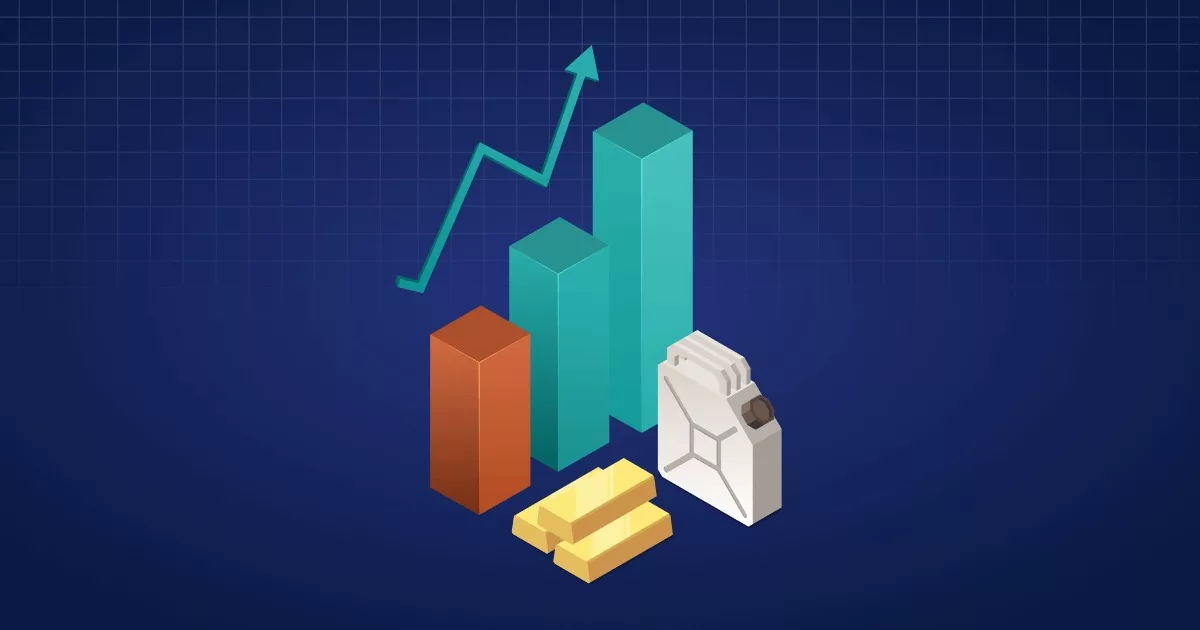
Commodities have been a valuable source of wealth for centuries and play an essential role in the global economy.
As a beginner investor, you may wonder how to invest in commodities and benefit from their potential for diversification, inflation hedging, and high returns.
While investing in commodities can initially seem daunting, it is a great way to diversify your investment portfolio and potentially reap significant rewards.
In this beginner’s guide, we will explore the different ways to invest in commodities, and the risks and benefits associated with investing in this exciting asset class.
Commodities as an Asset Class
Commodities are a class of assets that represent raw materials and natural resources such as metals, energy, agricultural products, and other primary goods. These assets are traded on commodity exchanges like Multi Commodity Exchange of India Ltd (MCX) and can be bought and sold like other financial instruments, such as stocks and bonds.
Commodities are an asset class due to their unique characteristics and potential benefits.
Firstly, commodities have a low correlation with other asset classes, such as stocks and bonds. It means they can serve as a diversification tool to reduce overall portfolio risk.
Also, commodities have an intrinsic value tied to their underlying supply and demand dynamics. Thus, it can hedge against inflation and currency fluctuations.
Why Invest in Commodities?
Investing in commodities offers several potential benefits for investors, including,
1. Diversification Benefits
As mentioned, commodities tend to have a low correlation with other asset classes, such as stocks and bonds. Thus, they can provide diversification benefits to a portfolio.
Adding commodities to a portfolio can reduce overall risk and increase returns.
2. Inflation Hedging
Commodities can be a valuable tool for hedging against inflation.
As the prices of goods and services increase due to inflation, the value of commodities can also rise, providing a hedge against the erosion of purchasing power.
3. Potential for High Returns
Commodities can provide attractive returns, especially during periods of high demand and limited supply. Commodities such as gold have historically performed well during economic uncertainty and market volatility.
For example, below is a quick snapshot of the gold market,
- Global Gold Market Capitalization = $13.3 Trillion (as of 2022)
- Gold Price CAGR = 9.4% (1998 to 2022)
- Level of Risk/Volatility = Moderate
Overall, commodities can be a valuable addition to an investment portfolio for investors looking to diversify their holdings, hedge against inflation, and achieve high returns.
Types of Commodities
Commodities can be broadly classified into four main categories — Energy, Metals, Agricultural Products, and Livestock
1. Energy
This category includes crude oil, natural gas, gasoline, and other energy-related products.
Geopolitical events and supply and demand dynamics heavily influence energy commodities.
2. Metals
This category includes precious metals such as gold, silver, and platinum, as well as base metals such as copper, aluminum, and nickel.
Metals are often used in industrial production and construction, and their prices can be affected by economic growth, supply and demand, and geopolitical events.
3. Agricultural Products
This category includes wheat, corn, soybeans, coffee, sugar, and cotton products.
Agricultural commodities are often influenced by weather patterns, global supply, and demand dynamics, and government policies related to trade and subsidies.
4. Livestock
This category includes live cattle, hogs, and pork.
Prices of livestock commodities can be affected by factors such as consumer demand, disease outbreaks, and government policies related to trade and subsidies.
How to Invest in Commodities
There are several ways for investors to invest in commodities,
1. Futures Contracts
Futures contracts are agreements to buy or sell a specific commodity at a set price and date in the future.
Investors can buy or sell futures contracts on exchanges such as the Multi Commodity Exchange of India Ltd, Chicago Mercantile Exchange or the New York Mercantile Exchange.
2. Options Contracts
Options contracts give investors the right, but not the obligation, to buy or sell a commodity at a specific price and date in the future.
Options contracts can provide flexibility and risk management options for investors.
3. Physical Commodities
Investors can also invest in physical commodities such as gold, silver, other metals, agricultural products, or energy commodities. This requires buying and storing the actual physical commodity, which can involve additional costs and logistics.
4. Exchange-Traded Funds (ETFs)
Exchange-traded funds (ETFs) are investment funds that trade on stock exchanges like stocks. Some ETFs invest directly in commodity futures contracts. In contrast, others invest in companies involved in producing or distributing commodities.
Factors Affecting Commodity Prices
Commodity prices can be influenced by a variety of factors, including,
1. Supply and Demand
The fundamental principle of supply and demand significantly affects commodity prices. When demand for a commodity exceeds its supply, prices tend to rise, and when supply exceeds demand, prices tend to fall.
2. Economic Factors
Economic factors such as global economic growth, inflation, and interest rates can also affect commodity prices. For example, when the global economy grows, demand for commodities tends to increase, leading to higher prices.
3. Geopolitical Factors
Geopolitical factors such as wars, trade policies, and political instability in commodity-producing regions can also affect commodity prices. For example, political unrest in major oil-producing countries can disrupt supply chains and cause oil prices to spike.
Other factors that can affect commodity prices include,
- Weather patterns which can affect agricultural commodities
- Technological advancements which can affect energy commodities
- Government policies such as subsidies or trade tariffs
Understanding the various factors affecting commodity prices is vital for investors looking to invest in this asset class.
Risks of Investing in Commodities
Investing in commodities comes with several risks, including,
1. Price Volatility
Commodity prices can be highly volatile can lead to significant fluctuations in the value of investments and result in potential losses for investors.
2. Liquidity Risk
Some commodities, especially physical ones, can be illiquid. It means they cannot be easily bought or sold. This can make it difficult for investors to exit their positions quickly and can increase the risk of losses.
3. Counterparty Risk
When investing in commodity futures contracts or options, investors are exposed to counterparty risk that the other party to the contract cannot fulfill their obligations. This risk can be mitigated by using reputable and well-established brokers or clearinghouses.
It is crucial for investors to carefully consider these risks and their risk tolerance before investing in commodities.
Conclusion
Investing in commodities is an excellent way for beginner investors to diversify their portfolios and achieve significant returns.
While risks are associated with commodity investing, such as price volatility and liquidity risk, the benefits, such as hedging against inflation and economic downturns, can outweigh the risks.
By understanding the different types of commodities available, their investing methods, and the factors that affect their prices, you can make informed decisions regarding adding commodities to your investment portfolio.
FAQs
1. What are commodities, and why are they valuable investments?
Commodities are raw materials or primary agricultural products traded on financial markets. They are valuable investments because they provide diversification benefits to an investment portfolio and can act as a hedge against inflation and economic downturns.
2. What are the different types of commodities?
There are several types of commodities, including
- Energy commodities such as crude oil and natural gas
- Precious metals such as gold and silver
- Industrial metals such as copper and aluminum
- Agricultural commodities such as wheat and corn
- Livestock such as cattle and hogs
3. What are the benefits of diversifying my investment portfolio with commodities?
Diversifying your investment portfolio with commodities can provide several benefits, including reducing overall portfolio risk and potentially increasing returns.
Commodities have a low correlation with other asset classes, such as stocks and bonds. It means they can help offset losses in those asset classes during market volatility.




